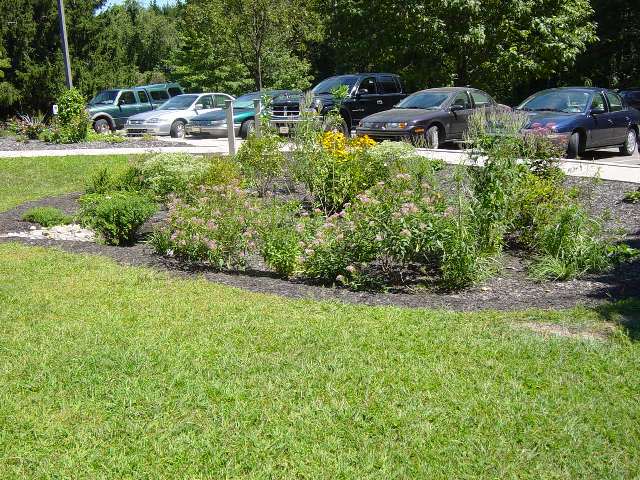News

Not Just a Hole in the Ground! Visually Pleasing Stormwater Best Management Practices

By: Ellen Enslin, CPESC, Program Manager
With a future of higher frequency and intensity storms combined with increased construction and impervious areas, it is now more important than ever for everyone to do their part in managing stormwater. However, the solution does not need to be boring holes in the ground with minimal plant or animal diversity. There are visually pleasing options available for managing stormwater on your property. Vegetated swales, native meadows, and rain gardens are good options for slowing down and spreading out the water to help prevent erosion and flooding downstream.
A rain garden is a depressed area on the landscape that collects rainwater from a roofs, driveways or other impervious areas and allows it to soak into the ground. Planted with native grasses, perennials, shrubs and trees, rain gardens can be a cost-effective way to reduce runoff on a property while creating beautiful landscapes that can add to the value of the property. Rain gardens can be installed to mimic natural processes; where rainfall ponds, is picked up by plants or absorbed into the ground, where it recharges nearby streams and groundwater. The plants and the infiltration process in rain gardens also help break down contaminants, keeping them out of local waterways.
Vegetated swales are low maintenance depressed areas planted with native grasses and wildflowers and maintained as a natural area. These areas have high aesthetic appeal, as tall grasses and wildflowers add interest, structure, color and wildlife to property and high pollutant runoff removal by increasing infiltration and evapotranspiration while filtering pollutants out of the water. Native meadows or “no mow” areas on the landscape can provide similar benefits.
Plant selection will bring life and diversity to your stormwater feature. Native plants, grasses, perennials, shrubs, and trees should be chosen by the amount of light they will receive (sun versus shade) and their ability to handle the periods of wet and dry they will experience throughout the year. Choosing plants with native pollinators in mind will bring birds, butterflies, dragonflies, bees, and other pollinators to your garden.
By looking at the way the water flows naturally on your landscape after a heavy rain, you can take advantage and enhance the existing features on your lot for minimal work and costs. Implementing a small landscape feature to manage polluted runoff can improve water quality and provide a visually pleasuring area for all to enjoy!
